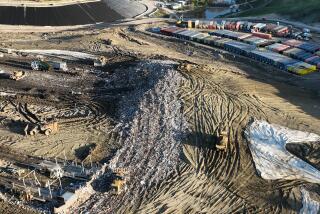Auditor slams California for Exide cleanup delays, says cost could reach $650 million

The cleanup of thousands of lead-contaminated homes, child-care centers, schools and parks surrounding the closed Exide battery recycling facility in Vernon is running behind schedule and over budget due to poor management by California regulators and has left children at continued risk of poisoning, according to a state audit released Tuesday.
The report by State Auditor Elaine Howleâs office criticized the California Department of Toxic Substances Control for delays, cost overruns, contracting problems and other shortcomings in its effort to remove lead contamination from properties across half a dozen communities in southeast L.A. County. The audit estimated the cleanup is likely to cost hundreds of millions of dollars more than the state has set aside.
For the record:
2:55 p.m. Oct. 28, 2020A previous version of this story said the Department of Toxic Substances Control was now cleaning about 20 properties a month, and has been updated to clarify that it refers to the number of properties cleaned per month during the first six years of the project.
Among the most troubling findings, according to the auditorâs office, was Toxic Substances Controlâs failure to remove lead-tainted soil from most of the 50 properties, including child-care centers, schools and parks, that it identified in the early stages of the cleanup as posing a particularly high risk to children.
âDespite the risk these properties present, DTSC has yet to clean 31 of them,â the audit said. âIn fact, it has cleaned only one of these properties since May 2018.â
At its current pace, the departmentâs cleanup of the 3,200 worst-contaminated properties will not be finished âuntil more than one year after the expected completion dateâ in June 2021, the audit found, âextending the time that residents in the cleanup site are exposed to dangerous levels of lead.â
Cleaning all 7,800 contaminated properties in the pollution zone stretching 1.7 miles from the closed plant could ultimately approach $650 million, the state auditor estimated.
California lawmakers have so far allocated more than $250 million for the cleanup of the most heavily contaminated properties, but Toxic Substances Control will exhaust that funding with 269 of those properties uncleaned, the audit found, and the department has no timeline or strategy to clean the other 4,600 properties that will remain contaminated.
Assemblyman Miguel Santiago (D-Los Angeles), who requested the audit, said âit is unacceptable that the department will run out of money that the state gave themâ and demanded âDTSC fix their mistakes and create a realistic plan to clean up every single contaminated property.â
Agency Director Meredith Williams said the department is learning from its mistakes and will implement all of the auditorâs recommendations. She acknowledged in an interview that âit did take us a while to come up to speed,â and said the department has cleaned an average of 20 properties a month during the first six years of the project. âWe are efficient. We control costs carefully. We learned every step of the way on this cleanup.â
About 2,000 properties have been cleaned since soil removal began in residential areas in 2014.
Among the recommendations in the report: That the department âimmediately begin cleaning all childcare centers, parks, and schools,â deploy enough resources to clean the 3,200 most polluted properties on time, set a schedule for cleaning all 7,800 contaminated properties and identify the amount of additional funding needed.
In a response letter released with the audit, Williams said the department does not currently have funding to clean the remaining 4,600 properties, and âwithout knowing a sustained level of funding, providing people in the community with an end date for the cleanup of their properties is at best a guess.â
Williams called it âthe largest, most logistically complex residential cleanup project the state of California has ever undertakenâ and said the department âhas cleaned up more properties, more quickly than any other residential lead cleanup in the nation.â
The state auditor countered that Toxic Substances Control âdid not provide any evidence to support its assertionâ about the pace of the Exide cleanup relative to other projects.
The audit came less than two weeks after a federal bankruptcy court approved a plan by Exide to walk away from the heavily contaminated Vernon facility and leave the cleanup to state taxpayers.
Assemblywoman Cristina Garcia (D-Bell Gardens) said she was disappointed that the findings validated the publicâs concerns that âthere is no clear plan to ensure all homes with unsafe lead levels get cleaned.â
âItâs maddening that DTSC has not prioritized cleaning of the schools, parks, and day-care centers, where children frequent, since they are the most vulnerable,â she said.
Garcia said the state should loan the toxic substances department money to keep the cleanup going and repay it using existing fees on lead-acid batteries, rather than waiting for those funds to come in over time.
âWe cannot use Exideâs bankruptcy as an excuse to not clean up these homes,â Garcia said. âOur next generation will not be left with a poisoned community.â
More to Read
Sign up for Essential California
The most important California stories and recommendations in your inbox every morning.
You may occasionally receive promotional content from the Los Angeles Times.











